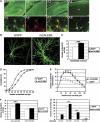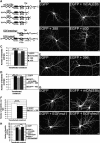The neural EGF family member CALEB/NGC mediates dendritic tree and spine complexity
- PMID: 17431398
- PMCID: PMC1864978
- DOI: 10.1038/sj.emboj.7601680
The neural EGF family member CALEB/NGC mediates dendritic tree and spine complexity
Abstract
The development of dendritic arborizations and spines is essential for neuronal information processing, and abnormal dendritic structures and/or alterations in spine morphology are consistent features of neurons in patients with mental retardation. We identify the neural EGF family member CALEB/NGC as a critical mediator of dendritic tree complexity and spine formation. Overexpression of CALEB/NGC enhances dendritic branching and increases the complexity of dendritic spines and filopodia. Genetic and functional inactivation of CALEB/NGC impairs dendritic arborization and spine formation. Genetic manipulations of individual neurons in an otherwise unaffected microenvironment in the intact mouse cortex by in utero electroporation confirm these results. The EGF-like domain of CALEB/NGC drives both dendritic branching and spine morphogenesis. The phosphatidylinositide 3-kinase (PI3K)-Akt-mammalian target of rapamycin (mTOR) signaling pathway and protein kinase C (PKC) are important for CALEB/NGC-induced stimulation of dendritic branching. In contrast, CALEB/NGC-induced spine morphogenesis is independent of PI3K but depends on PKC. Thus, our findings reveal a novel switch of specificity in signaling leading to neuronal process differentiation in consecutive developmental events.
Figures









Similar articles
-
B56beta, a regulatory subunit of protein phosphatase 2A, interacts with CALEB/NGC and inhibits CALEB/NGC-mediated dendritic branching.FASEB J. 2008 Jul;22(7):2521-33. doi: 10.1096/fj.07-096115. Epub 2008 Apr 2. FASEB J. 2008. PMID: 18385213
-
Different roles of the small GTPases Rac1, Cdc42, and RhoG in CALEB/NGC-induced dendritic tree complexity.J Neurochem. 2016 Oct;139(1):26-39. doi: 10.1111/jnc.13735. Epub 2016 Aug 4. J Neurochem. 2016. PMID: 27412363
-
Reelin signals through phosphatidylinositol 3-kinase and Akt to control cortical development and through mTor to regulate dendritic growth.Mol Cell Biol. 2007 Oct;27(20):7113-24. doi: 10.1128/MCB.00928-07. Epub 2007 Aug 13. Mol Cell Biol. 2007. PMID: 17698586 Free PMC article.
-
Rho GTPases, dendritic structure, and mental retardation.J Neurobiol. 2005 Jul;64(1):58-74. doi: 10.1002/neu.20153. J Neurobiol. 2005. PMID: 15884002 Review.
-
[On the function of dendritic filopodia].Rev Neurol. 2001 Dec 16-31;33(12):1158-66. Rev Neurol. 2001. PMID: 11785056 Review. Spanish.
Cited by
-
Plasticity-Related Gene 5 Is Expressed in a Late Phase of Neurodifferentiation After Neuronal Cell-Fate Determination.Front Cell Neurosci. 2022 Apr 15;16:797588. doi: 10.3389/fncel.2022.797588. eCollection 2022. Front Cell Neurosci. 2022. PMID: 35496908 Free PMC article.
-
NaHS Protects against the Impairments Induced by Oxygen-Glucose Deprivation in Different Ages of Primary Hippocampal Neurons.Front Cell Neurosci. 2017 Mar 7;11:67. doi: 10.3389/fncel.2017.00067. eCollection 2017. Front Cell Neurosci. 2017. PMID: 28326019 Free PMC article.
-
Pathogenesis of Börjeson-Forssman-Lehmann syndrome: Insights from PHF6 function.Neurobiol Dis. 2016 Dec;96:227-235. doi: 10.1016/j.nbd.2016.09.011. Epub 2016 Sep 12. Neurobiol Dis. 2016. PMID: 27633282 Free PMC article. Review.
-
CLIP-170 and IQGAP1 cooperatively regulate dendrite morphology.J Neurosci. 2011 Mar 23;31(12):4555-68. doi: 10.1523/JNEUROSCI.6582-10.2011. J Neurosci. 2011. PMID: 21430156 Free PMC article.
-
α-Tocopherol and Hippocampal Neural Plasticity in Physiological and Pathological Conditions.Int J Mol Sci. 2016 Dec 15;17(12):2107. doi: 10.3390/ijms17122107. Int J Mol Sci. 2016. PMID: 27983697 Free PMC article. Review.
References
-
- Aono S, Keino H, Ono T, Yasuda Y, Tokita Y, Matsui F, Taniguchi M, Sonta S, Oohira A (2000) Genomic organization and expression pattern of mouse Neuroglycan C in the cerebellar development. J Biol Chem 275: 337–342 - PubMed
-
- Atwal JK, Massie B, Miller FD, Kaplan DR (2000) The TrkB-Shc site signals neuronal survival and local axon growth via MEK and PI3-kinase. Neuron 27: 265–277 - PubMed
-
- Banker G, Goslin K (eds). (1998) Culturing Nerve Cells. Cambridge, MA: MIT Press
-
- Brewer GJ, Torricelli JR, Evege EK, Price PJ (1993) Optimized survival of hippocampal neurons in B27-supplemented neurobasal, a new serumfree medium combination. J Neurosci Res 35: 567–576 - PubMed
-
- Brummelkamp TR, Bernards R, Agami R (2002) A system for stable expression of short interfering RNAs in mammalian cells. Science 296: 550–553 - PubMed
Publication types
MeSH terms
Substances
LinkOut - more resources
Full Text Sources
Molecular Biology Databases
Miscellaneous

